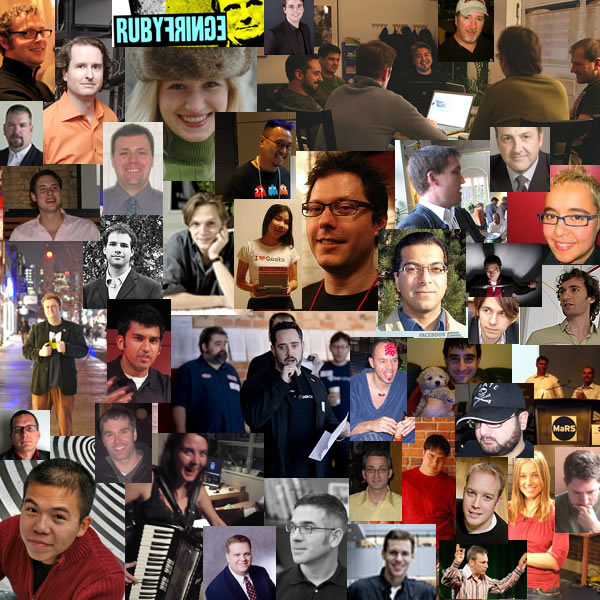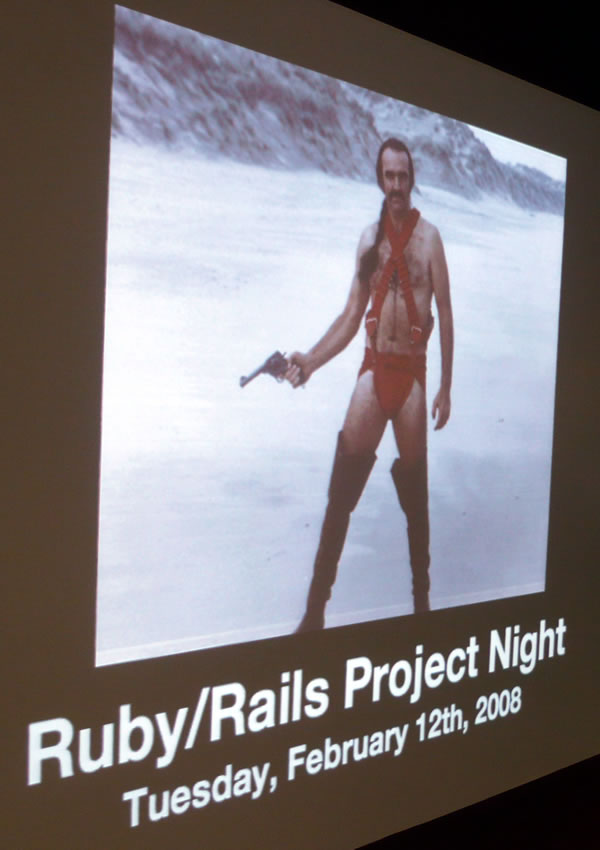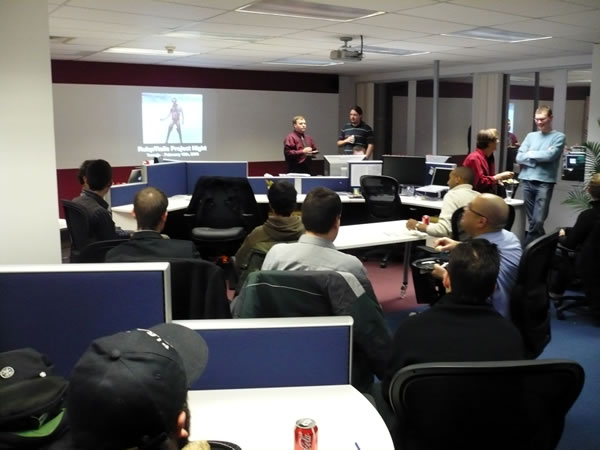They see it in pretty much the same way that Grandma sees the remote:

They see it in pretty much the same way that Grandma sees the remote:

I fell in love with Montreal in my late teens. It’s quite unlike most cities in North America — you can practically feel the place’s history, and everything from its architecture to the “feel” of its streets just seems different. It’s like having a little bit of Europe, but closer by and cheaper to get to. If you’re from North America and looking for a different vacation destination and on a budget, I recommend Montreal.
Today’s Montreal Gazette features an article titled Silicon Island?, which takes a look at their high-tech community’s grassroots movement:
Inspired by the collaborative nature of the Internet, local geeks with bright ideas started meeting at informal, community-organized events called BarCamps. The global movement that began in the Silicon Valley was the grassroots retort to stuffy, invitation-only tech conferences. In a BarCamp, computer whizzes show the first drafts of their garage projects to anyone who will listen.
This type of networking results in lasting connections that can pay off. Now when [George Favvas of Montreal-based SmartHippo.com] needs someone with a particular skill, he puts the word out on his blog, his Facebook profile or on his LinkedIn page, a social network for business contacts. Other bloggers write about it. Someone who knows just the guy gets wind of it, and Favvas has a candidate in a few hours.
This way of doing things has been so fruitful that it’s being seen as a model for other sectors of the technology industry, like telecommunications and life sciences.
“The young entrepreneurs today are different from the IT entrepreneurs of the ’80s and ’90s,” said René Barsalo, the director of strategy and liaison for the Society for Arts and Technology, which has become the preferred venue for local tech gatherings.
“They are very good at organizing themselves. … It’s sad to see more established companies not seeing this as a core of business,” he said.
There’s also a gathering called YULbiz, a monthly get-together for local business bloggers (YUL is the airport code for Montreal’s Pierre Trudeau airport). Montreal StartUp encourages successful entrepreneurs to become angel investors. Guy Kawasaki’s Garage Technology Ventures has a branch office in Montreal.
As with Toronto, the chicken-and-egg problem also plagued Montreal. As the article puts it: “Do risk-takers attract smart money, or does the availability of money encourage risk-takers? Ideally, both factors are at work, in a mutually reaffirming symbiosis.” The seed money is now coming in, and things are looking up:
With its pool of tech talent, the emergence of seed money, and a budding network of mentors, “Montreal has the right mix of elements and we’ll see it really flourish next year,” [Austin Hill] said.
The next step is to get people from different tech and business sectors talking to each other. René Barsalo, the director of strategy and liaison for the Society for Arts and Technology (“the preferred venue for local tech gatherings”) says that in his ideal world, a presentation by a 3D animator would have engineers, musicians, medical technicians and furniture designers in the audience.
The article closes with a line that people in the Toronto tech community will find familiar: “The grassroots is moving up quite nicely, but a top-down movement isn’t happening at all.”

Jenny Lam, Hillel Cooperman and Walter Smith of the software company Jackson Fish Market.
Seattle Taps Its Inner Silicon Valley is a recent New York Times article that opens with a pretty dramatic statement that I hope we’ll someday say about this weblog’s home city, Toronto: “Many communities dream of becoming the next Silicon Valley. [Seattle] is actually doing it.”
The city has its share of big players: Microsoft has its headquarters the nearby suburb of Redmond as well as satellite offices in Seattle proper, Amazon is based there, Google has a research lab there and Nintendo’s American headquarters is also in the area. However, the real topic of interest — from both the article’s point of view as well as mine — is the city’s startup ecosystem. “More young companies are moving in downtown,” says the article, “near the art galleries and bookstores around Pioneer Square. Still others are spreading into the surrounding suburbs.” A number of these startups fall into interestingly-named categories:
Silicon Valley got its start as the “Fairchildren” left Fairchild to form their own companies, whose employees moved between them or formed their own spin-off companies, creating the atmosphere of cross-pollination that turned the area into a high-tech Mecca. The same thing seems to be happening in Seattle, according to Walter Smith of Seattle software company Jackson Fish Market: “Seattle is like an adolescent version of Silicon Valley,” he says.
Just as Silicon Valley has Stanford, Seattle has University of Washington, which the article says is fostering the area’s entrepreneurial spirit in the same way. Another similarity is the area’s old industry: aerospace, which provided an earlier boom in the Seattle area, just as it did in the Valley. Now the entrepreneurs and venture capital are moving in, and there are social networks, support businesses and a business culture that views failure as a badge of honour, not shame.

Scenes from the Valley’s El Camino Real (left) and Seattle’s Pioneer Square (right).
The New York Times article on Seattle inspired this response on Seattle-based Redfin’s corporate blog: How Green Was My Valley. Where the Times chose to focus on the similarities between the Valley and Seattle, How Green Was My Valley takes the opposite tack and focuses on the differences. some of which are:

A whole mess of Toronto tech people. Can you identify them all?
Along with Leila Boujnane, David Crow, Jay Goldman and Greg Wilson, I help put together the DemoCamp gatherings here in Toronto. As part of this group, as well as a Toronto-based techie and a long-time resident of this city (since 1975!), I have an interest in making Toronto a great place to work, live and play, in both my geek and non-geek modes.
As I’ve written before, I think that Toronto is an underappreciated gem of a city and that a lot of the elements required to make Toronto a high-tech startup hub are in place. We’ve got:
Okay, maybe the last item in that list isn’t absolutely necessary, but it couldn’t hurt.
There are a number of hurdles that we need to clear, not the least of which are the timidity of local investors and the sense among a lot of people here that “making it” means getting a job in a big company, not starting your own. Perhaps it’s a symptom of the national character; after all, Canada was founded by people loyal to the British Empire, people who said “Hey! We like being a colony! Taxation without representation? Fine by us! So King George talks to trees…who doesn’t?!”
I’m glad that there are a lot of people in Toronto who are thinking about this sort of thing, and I look forward to talking with them, making plans and putting them into action. Over the next little while, I’m going to talk about what it would take to build up Toronto as a high-tech hub and a livable city. Watch this space!
In case you missed them, here are some links to older articles of mine about what it would take to turn Toronto into a startup hub:
According to AppleInsider, Google reports that they had been getting 50 times more search requests coming from Apple iPhones than any other mobile handset. This was so surprising that they originally suspected it had made an error in reading their own data, but it turned out to be true. It’s quite possible that in a few years, searches made from mobile devices will outnumber searches made from desktops.
The devx article 8 Simple Rules for Designing Threaded Applications has some good advice:

Sean Connery’s character, “Zed” from the movie Zardoz has become the unofficial mascot of my Project Night opening monologues.
In spite of yesterday’s all-day snowstorm and sub-freezing temperatures (-10 C / 14 F), about a couple of dozen people still showed up for last night’s Ruby/Rails Project Night, TSOT’s monthly session where developers from Toronto and surrounding areas get together to see in-depth presentations on projects done using Ruby and Rails.

One of the slides from my opening monologue.
As per tradition (well, as much tradition as you can get with this being only the second Project Night), I presented the opening monologue, titled Do the Stupidest Thing That Could Possibly Work. The basic premise: if a stupid idea works for you, it isn’t stupid. It’s something I’d been meaning to do — a live version of this article from last June.

The first presenter was Rowan Hick, with his presentation How to Avoid Hanging Yourself in Rails, a guide to getting the most out of ActiveRecord. He billed it as something intended for developers new to Rails or intermediate developers who’ve been frustrated by Rails’ database performance.
A good chunk of his presentation focused on ways of speeding up getting results from ActiveRecord, which can summarized in a chart like this:
| Method | Requests per second | Speed index | Notes |
|---|---|---|---|
find(:all) |
5.26 | 1x (baseline) | Straight out of every Rails tutorial every written. |
find(:all, :include) |
7.70 | 1.4x | A little better… |
find(:all, :select, :include) |
15.15 | 2.88x | Nearly 3 times the speed for only a little work. |
find_by_sql |
28.90 | 5.49x | Considerably faster, but no longer database-independent and harder to maintain. Still, I can see optimizations like this in my future… |
| Merb | 38.56 | 7x | Next to Rails, Merb is blazingly fast, and Rowan says you can use code nearly identical to Rails. I’ll have to give it a peek sometime… |
Rowan is kindly sharing the slides from his presentation — you can get it from this entry in his blog.

Andrew, Pete and Krispy were among those who braved the snow to attend. Thanks for coming out, guys!
Photo courtesy of Mike Bowler.
Next came Mike Bowler, who presented Easy Branding Tools, his one-stop online shop for ordering all sorts of things related to your brand — from business cards and stationery to domain names — powered mostly by Rails. Notable points in his presentation included:
script/runner for this project, but for future apps, he’s more likely to use backgroundrb.
The final presentation was Luke Galea’s who presented CRMS: Clinical Research Management System, an enterprise-class Rails app that manages drug and treatment experimental trials carried out at various hospitals across the United States.he covered all sorts of aspects of building such an app, which included using databases not typically used with Rails (the hospitals tend to use SQL Server), offloading some work to apps implemented in other languages (some hairy calculations are handed off to an engine written in Prolog), and building a “vanilla” app with features needed by all the research hospitals, and “spicing” them individually as needed by each client.

We kept things moving quickly so that people could brave the snow and go home, so the event wrapped up at 8:00 p.m.. More than a few decided to join us at the TSOT development team’s semi-official watering hole, Hemingway’s, to hoist some pints and socialize.

Joey deVilla and Corina Newby.
I’d like to thanks the presenters for the work they put into their presentations and the attendees for braving the snow and coming out! I’d also like to say thanks to my co-worker and TSOT’s VP of Public Relations, Corina Newby, for doing the heavy lifting in getting the event together.
If you’ve got a Ruby or Rails project that you’d like to show off in front of your peers in a 20- to 30-minute presentation (where you can get as in-depth and tech-y as you like), we’d like you to present! Email either Corina or me for details.
Keep an eye open for announcement of the next Ruby/Rails Project Night!
New tracks for Rock Band available for download via XBox Live have been announced: Complete Control by The Clash, Truth Hits Everybody by The Police and Teenage Lobotomy by The Ramones. They’re available for 160 Microsoft Points each for 440 Microsoft Points for the set of three.